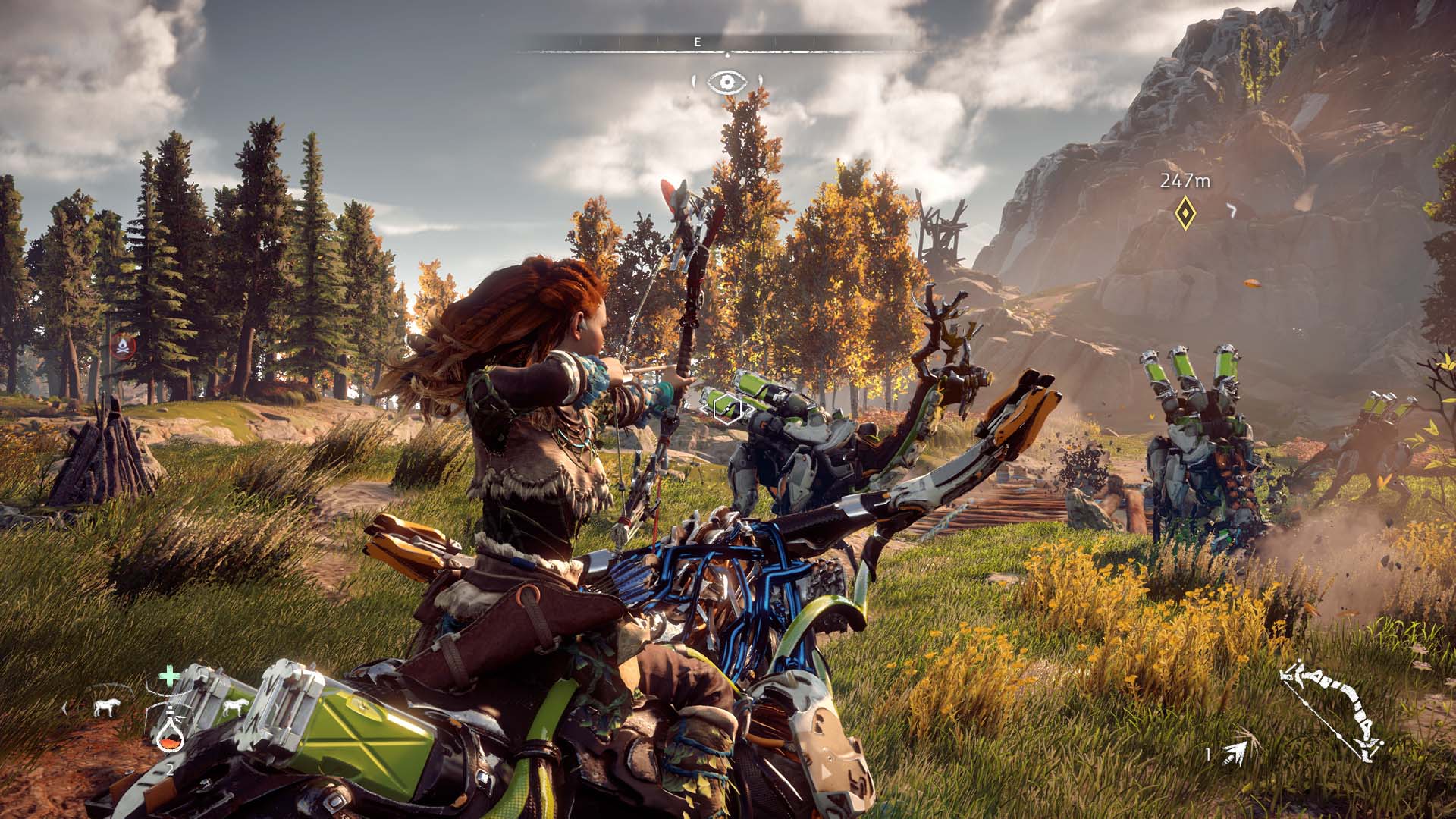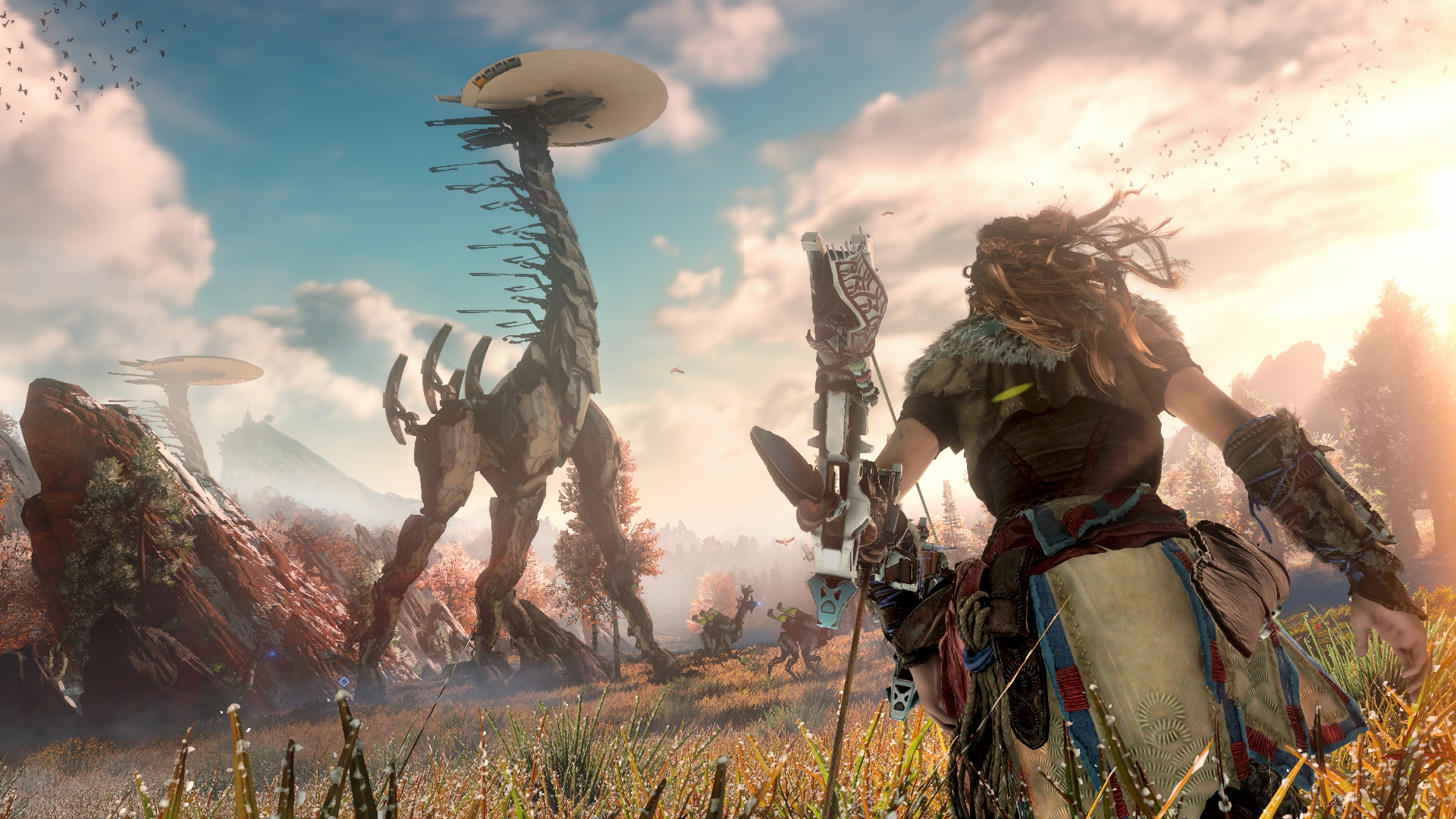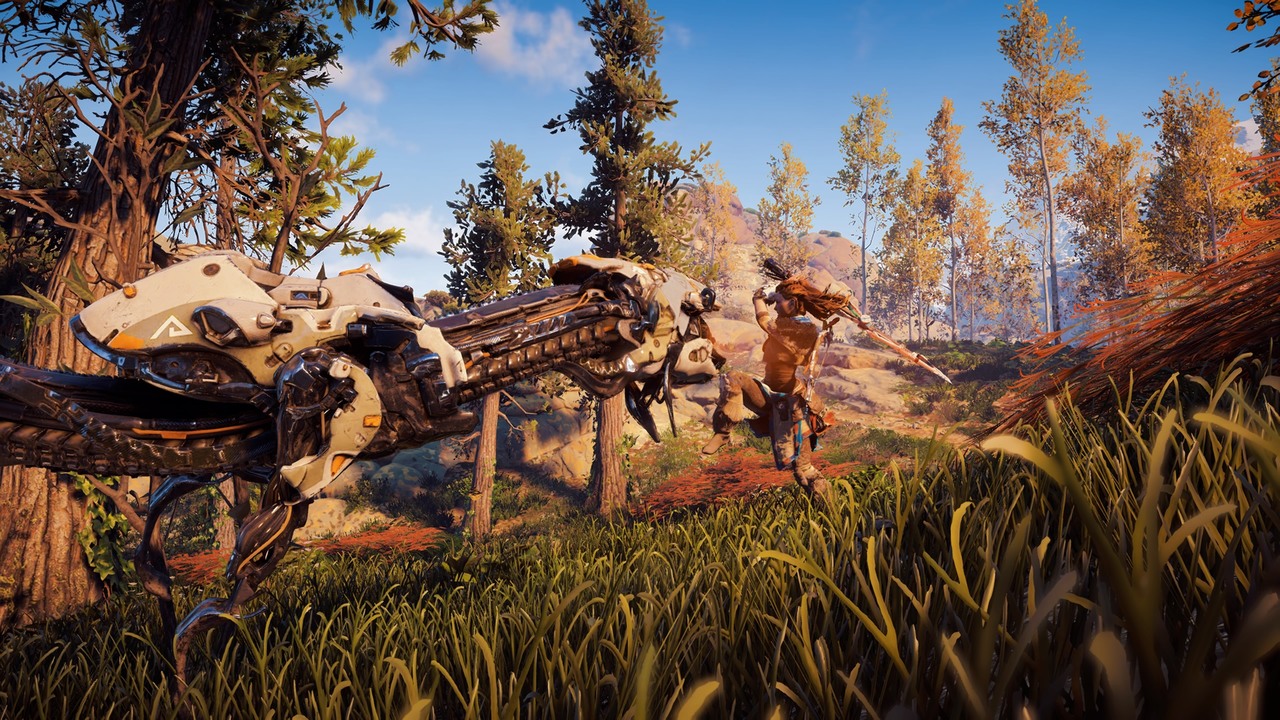Horizon comes from Guerilla Games, developers of the Killzone franchise. It’s not the kind of thing you’d expect from Guerilla. The four games in the Killzone franchise were all first-person shooters without a very strong narrative. They were, plainly put, simple games. So for Guerilla to go from those into a story driven open world game, one can’t blame people for being worried. For the most part, Horizon sticks the landing.
In order to talk about Horizon’s characters and story, we need to talk about its world. Set hundreds of years after the end of the world as we know it, Horizon takes place in the era when humans have begun to rebuild civilization. Why did the world end? Well, no one is really sure at the beginning of the game. All that’s known is that the earth is populated by a race of mechanical animals, and that they’re very dangerous.
The humans in this age have adapted to their surroundings. They’ve learned to hunt the machines and use them to help build themselves up. Throughout your travels you’ll meet all sorts of people, who – including your own – use the machines as part of their weapons, dress, and infrastructure. Like people centuries ago would use animal hides and teeth for weapons or jewelry, so too do the people of Horizon with these machines.

Your quest as Aloy will take you through a sprawling open world with environments that range from lush forests, to barren deserts, to snowy mountains. The story will take you to some unique areas as see city ruins of the Old Ones, and the vast network of camps and castles that the new people have built. You’ll even discover dead machines known as Titans, serpents that are long since dormant, tangled in the bodies of mountains.
Despite being a vast, open world, the world is almost too open. Each central area has a ton of side quests to take on, but there’s very little going on in the wilderness. Aside from the occasional corrupted zone and running into a pack of hunters fighting metal birds, nothing is happening. It’s just you and the machines. There is plenty to find in the world, bandit camps, hunting trials, cauldrons, even little mysterious treasure, but in between all these things is the vast nothingness. It’s a bit of a bummer because the world is beautiful, but so little goes on outside the walls of villages or castles that it makes you wonder why it was put there in the first place.
During your travels, you’ll come across a variety of machines. Most of which have designs inspired by animals both extinct and currently among us. The Sawtooth and Ravagers are based off tigers and sabertooths. Stormbirds are giant eagles with a wingspan so large a single gust will knock you off the ground. The mighty Thunderjaw is basically a robotic t-rex and it’s as formidable in battle as you would imagine. Aside from these designs you have others that resemble horses, deer, giant crabs, rhinos, and so on. Each is wonderfully designed and fits perfectly within the world that Horizon presents.
Combat against these monsters is key and definitely one of Horizon’s more exciting activities. Each machine must be dealt with in a certain way. Most of the time this means peeling off armor in certain spaces and getting to their weak spots. Some require elemental damage, and others can be lured into traps. Later in the game you’ll be granted the ability to override the machines so that they will work for your side. This can be valuable when you’re stuck in the middle of a battle between two very strong monsters. Get yourself into stealth mode, sneak up behind the unaware machine, and it’s yours.

All of these options give you endless possibilities on how to handle combat. The issue is that most of them are never needed. Aside from tear arrows – arrows that do no damage but instantly take armor off machines – and the upgraded basic arrows, everything else is just a fun addition. That said, I wound up using almost all the tools in my arsenal throughout the game to defeat varying types of machines and situations. While some of these tools aren’t necessary, they do help change up the experience and can definitely make certain fights easier to handle.
In terms of visuals, Horizon is easily the best looking game on the PlayStation 4. There are no loading zones in the entire game, except when you fast travel, and the game holds up despite that. There’s little to no frame hiccups, even in areas with tons of enemies. The character design is top notch. Everyone looks unique but in a way that makes them fit into the world. The landscape, in each of its biomes, look amazing as Aloy runs through the desert, hides in the jungle, or climbs through snow covered mountains.
That doesn’t mean Horizon is perfect though. The character animations tend to get worse the further from the main plot they get. Characters like Aloy look amazing and have decent facial animations, but the people giving you side quests and errands can sometimes look a little less worked on than everyone else. Some of the lip syncing isn’t perfect either, but this was a minor distraction and didn’t really take away from the cutscenes.

A random note while we’re talking about characters. Several well known voice actors portray most of the main cast. Sometimes this results in the character looking like the voice actor in terms of motion capture or simply pure design aesthetic. Horizon avoids that, no one looks like the actor that’s giving them life, with one notable exception. Actor Lance Riddick (who recently portrayed a character in Quantum Break) plays one of the more mysterious characters in the game. His character also looks exactly like him, just in the Horizon universe. It’s a little fourth wall breaking and I’m not really sure what the motivation behind that decision is. Everyone looks like they fit and belong in this world, and then there’s that actor I know from that TV show. It’s not a huge deal, more strange than anything else.
Horizon also suffers from a few technical hiccups. When you rescue prisoners in bandit camps, they’re supposed to join your team. This happens most of the time, but even when it does, their weapons simply spawn out of nowhere and draw onto their model. There were several times I would open the map and I would see nothing but the little symbols for collectables or landmarks. The map itself wouldn’t get drawn in. There were occasions where character faces wouldn’t appear until I was nearly on top of them. These aren’t major, but together they can be bothersome.
All that said, the story is the where Horizon shines the most. All the major questions asked by the story are answered by the end. Mysteries are satisfied, character arcs come to completion, and all in all we have one of the best AAA video game stories ever written. Naturally, there’s a little left dangling for the prospect of a sequel, but those small moments aside, it was nice to see how Guerilla spent the time to make sure we learn everything we need to about the world. Where the machines came from, why the world ended, and so on, all things you’ll learn over the course of twenty-five hours or more.
Horizon: Zero Dawn is a triumph. Even in spite of its technical hiccups and empty open world, Horizon’s beautiful landscapes, fascinating characters, and deep story are all worth playing for.
Game was reviewed on a base PS4 model.
